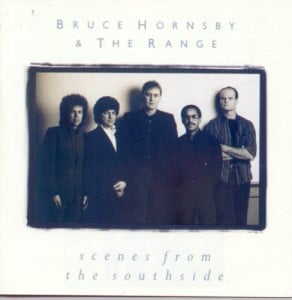Released: May 3 1988 Chart: #5 US

- Look Out Any Window 5:28
- The Valley Road 4:42
- I Will Walk with You 4:34
- The Road Not Taken 7:06
- The Show Goes On 7:30
- The Old Playground 4:25
- Defenders of the Flag 4:27
- Jacob’s Ladder 4:35
- Till the Dreaming’s Done 5:13
Your favourites:
Personnel: Bruce Hornsby (piano, accordion, synthesizer, vocals), George Marinelli (guitar, mandolin., vocals), Peter Harris (guitar, mandolin.), Joe Puerta (bass, vocals), John Molo (drums), Huey Lewis (harmonica), Jeff Gerson (percussion), Jimmy Bralower (drum programming)
Reviews:
Directpopmusic.com Epinions Rolling Stone: “Rather than merely echo the promise of The Way It Is, Scenes from the Southside, this band’s sophomore effort, fulfills it. Hornsby – the man who singlehandedly reestablished the grand piano as a viable rock instrument in the otherwise synthesized Eighties – fleshes out his keyboard runs. At the same time, the members of the Range manage to achieve what just barely eluded them on The Way It Is: the right mix of rock, country and jazz”.
The Washington Post, May 15 1988: The Grammy Award for Best New Artist of 1986 went to Bruce Hornsby and the Range for their debut album, “The Way It Is.” Oddly enough, Hornsby and other nominees for that award-Timbuk 3, Glass Tiger and Nu Shooz-have just released their follow-up albums, one right after another. And as it turns out, all four groups prove that they have one thing-and perhaps only one thing-in common: an eagerness to pick up precisely where they left off. Hornsby’s “Scenes From the Southside” (RCA 6686-1R) continues the work he started on his first album and, from a lyrical standpoint at least, does so brilliantly. A fan of southern novelists, Hornsby again demonstrates a similar gift for storytelling on songs such as “The Valley Road,” a small-town tale of star-crossed lovers and the price they have to pay. What he leaves out of the story is just as important as what he puts in. He trusts the listener to fill in the spaces. The album does have one gnawing flaw, however. Nearly every track is burdened by a backbeat so rigid and predictable that it deflates Hornsby’s piano playing or, worse, sets up the kind of hand-clapping percussion common to the most tired forms of funk and pop jazz. Clearly, Hornsby is trying to extend his reach on this album, combining more elements of rock and jazz (on “The Road Not Taken” and “Valley Road”) than in the past. But for all his percussive might, he can’t help but sound more like Ramsey Lewis than McCoy Tyner when the metronomic beat boxes him in.
Miami Herald, May 26 1988: If the lilting, troubadour-style acoustic piano on The Way It Is was a fluke success, Bruce Hornsby and the Range, the 1986 Best New Artist Grammy winner, is finished. Hornsby’s primary melody instrument, the piano, dominated the landscape of The Way It Is. With lines inspired by Elton John and Keith Jarrett, he charmed the Top 40, bringing a smooth, insightful, front-porch feel to increasingly alienated pop.
The Advocate (Baton Rouge, LA), June 10 1988: There’s something infuriating about anyone who can make music this commercial and seductive. At first, there’s a desire to hate those trickling piano riffs which permeate much of Bruce Hornsby’s records. Somehow, that very element starts slipping into the subconscious and, before you know it, you’ve been hooked. Again.
Boston Globe, May 4 1988: “The songs have a stately refinement similar to those on the debut album, but their meanings are deeper. “The Valley Road,” which just set radio history by being picked up by a record-breaking 186 stations in its first week, describes a plantation romance in which a field hand impregnates the owner’s daughter, causing a townwide scandal. “Standing like a stone on the old plantation / The rich old man would have never let him in / Good enough to hire, not good enough to marry,” Hornsby sings while his band, the Range, paints an evocative mood behind him.”
